Samsung Galaxy S 4 Review - Part 1
by Brian Klug on April 24, 2013 12:01 AM ESTBattery Life and Charge Time
The Galaxy S 4 features a removable 9.88Wh battery with 3.8V chemistry. The battery design is par for the course for any high end smartphone, but the fact that it's removable remains a staple of the Galaxy S design. Whether or not the bulk of consumers actually use the flexiblity offered by a removable battery is up for debate, but there's no doubt about the fact that Samsung has a strong following of users who appreciate the feature.
Unfortunately, only having access to the Sprint version of the Galaxy S 4 to review, most of our battery life tests on the cellular network aren't all that useful. The good news is that our WiFi tests should at least give you an idea of how well the SGS4 will compare to the HTC One when both are on the same network. We're using the latest revision of our smartphone battery life test to compare performance of all the key players here. This is now our sixth revision of the battery life test, and we feel is the optimal balance between challenging workloads and idle time. The basic overview is the same as the previous test — we load webpages at a fixed interval until the handset dies, with display set at exactly 200 nits as always. Power saving features are disabled if they turn on automatically, and background account sync is disabled. The test is performed over both cellular data on all available air interfaces and over WiFi in an environment with good signal levels. The new test has decreased pause time between web page loads and added a number of JavaScript-heavy pages. I sat down with some UMTS RRC (Radio Resource Control) emulator tools and also made sure we had a good balance of all the RRC states (DCH, PCH if possible, FACH, IDLE) so we weren’t heavily biased towards one mode or the other.
As the most relevant comparison of platforms we have today, we'll start with the WiFi version of our web browsing test:
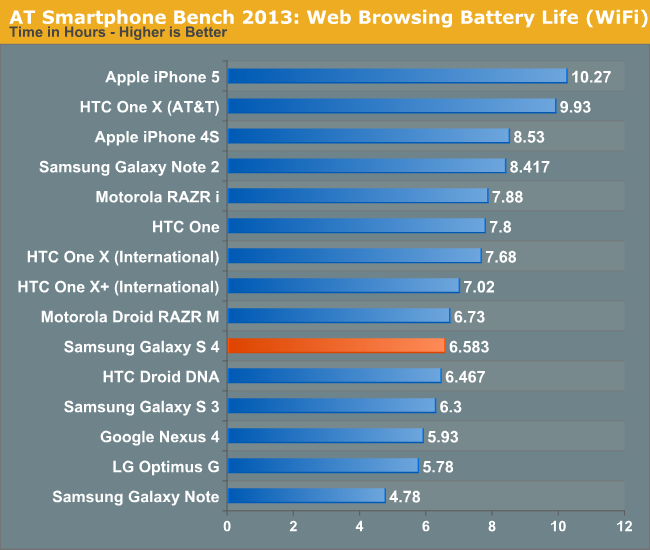
On WiFi the Galaxy S 4 falls behind the HTC One by an appreciable amount, however there's still an improvement in battery life compared to the Galaxy S 3. The Galaxy S 4's battery life isn't bad by any means, but do keep in mind that this is a large phone with a large display and a very powerful SoC. For much of the past year we've been talking about an increase in dynamic range in total platform power of high end smartphones and the Galaxy S 4 is no exception. Run it at full brightness or keep many cores running in their maximum performance states for a considerable period of time and you'll be greeted by a phone that's quickly in need of a power outlet.
As I mentioned earlier, we only have access to the Sprint version of the Galaxy S 4 at this point which unfortunately means that our 3G results aren't all that comparable to other devices here.

Even on Sprint, the Galaxy S 4 does surprisingly well.
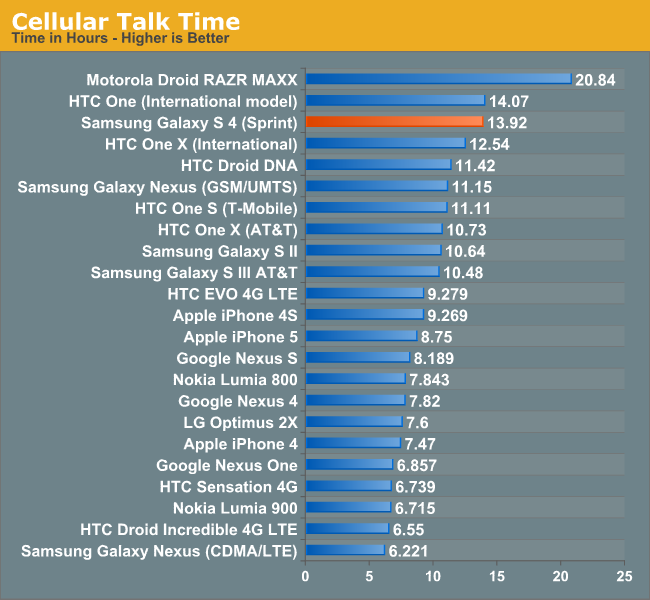
Talk time is excellent on the Galaxy S 4, with the phone delivering effectively the same battery life as the HTC One. Without having to power on that huge display, the Galaxy S 4 can last for a very long time on a single charge.
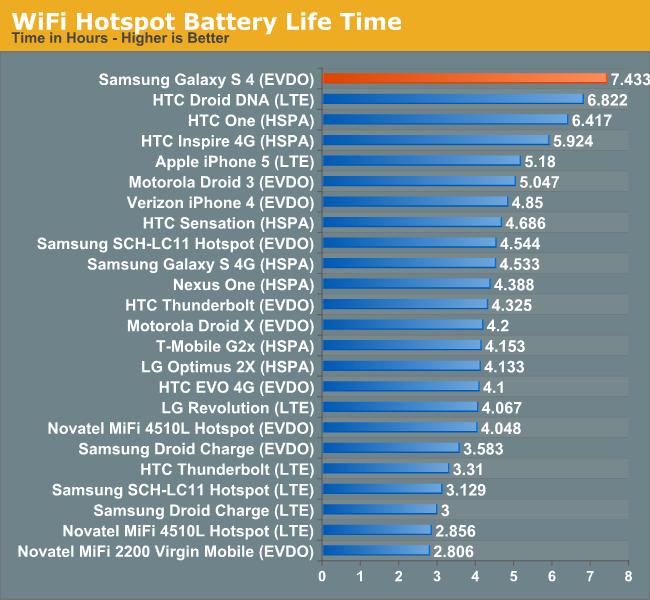
A combination of the Sprint network and the fact that the Galaxy S 4's display remains off during our hotspot test resulted in great battery life here as well. Again, this data isn't all that useful if you're not on Sprint but Samsung tells us we should be able to get our hands on an AT&T SGS4 in the not too distant future.
Charge Time
Samsung appears to implement Qualcomm's Quick Charge specification in the Galaxy S 4 and its bundled charger. I realize we haven't done a deep dive into what Quick Charge is and how it works, but I'll try to go through a quick explanation here. Most conventional chargers are linear, they take a fixed amount of input current (at 5V) and pass it along to the device being charged. The problem is that at deeply discharged states, the device's battery might be at a substantially lower voltage. A traditional linear charger won't change the current supplied based on the voltage of the battery being charged, and as a result can deliver sub-optimal charge times. When implemented, Qualcomm's Quick Charge technology can vary output current based on the voltage of the battery being charged, which results in less power being dissipated as heat and more being delivered to charging the battery itself. The table below helps illustrate the savings:
Quick Charge, at least in its currently available 1.0 specification, is still bound by the 5V limits of the USB BC 1.2 specification. The next revision of Quick Charge will enable higher voltage operation for even faster charge times.
| Qualcomm Quick Charge 1.0, Theoretical Example | ||||||
| Input Current @ Voltage | Input Power | Output Current @ Discharged Battery Voltage | Output Power | |||
| USB BC 1.2 - Linear Charger | 475mA @ 5V | 2.375W | 475mA @ 3V | 1.425W | ||
| Qualcomm Quick Charge 1.0 | 475mA @ 5V | 2.375W | 700mA @ 3V | 2.100W | ||
The non-linear nature of Quick Charge significantly shortens charge time, particularly in the very early stages of charging when the device's battery is presumably fully discharged. As the device's battery voltage increases, current delivery tapers off and the QC advantage is no longer as great as a standard USB BC 1.2 solution. The end result though is significantly improved charge times.
The graph below shows the benefits of using Samsung's own charger vs. a standard charger that implements the USB BC 1.2 specification. When used with the bundled charger, the Galaxy S 4 recharges much faster than HTC's One, despite using a larger battery. Obviously the Galaxy S 4 will charge with any USB charger, but the charge time will simply be longer. Samsung uses a voltage divider and signals the presence of their own charger by sending 1.2-1.3 V across the D+ / D- pins, this is similar to what Apple does with 2.0 or 2.8 V across the pins for various USB chargers they've shipped over the years. This signaling is essentially Samsung's proprietary tablet charging signaling which they've employed on the Galaxy Note 2 and now SGS4, in fact the two use the same exact charger, so it's worth tossing out your old ones and getting the appropriate one to take advantage of the faster charging.
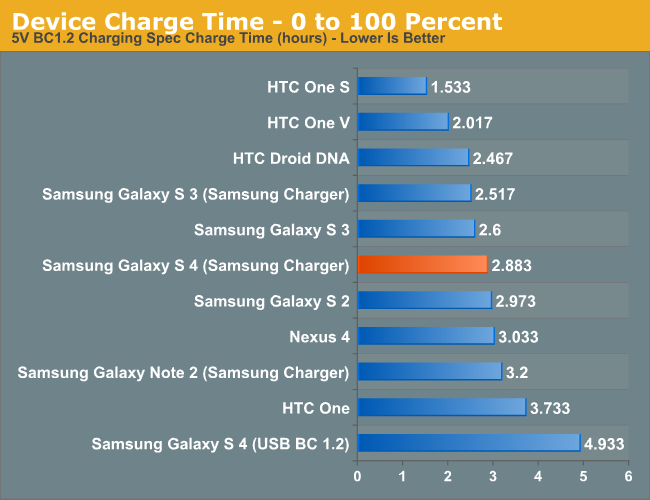


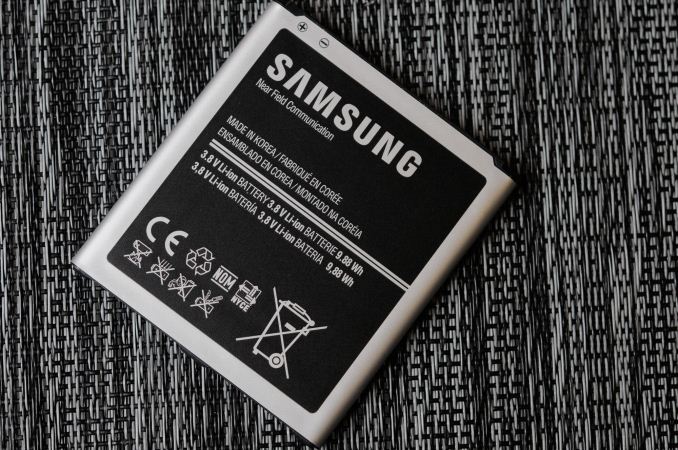








335 Comments
View All Comments
Roffles12 - Wednesday, April 24, 2013 - link
fans of the solid aluminum chasis are a very vocal and illogical minority. very annoying in fact. i have yet to hear any logical argument for why it's better. "it feels nicer in the hand" isn't a reason, but rather a completely subjective opinion. by my logical observation, the aluminum phones are actually more fragile and prone to scratching. aluminum is also more rigid which means it will have greater energy transfer on shock impact, resulting in a greater chance of shock energy transferring to the screen, thus damaging it. you're almost forced to purchase a case to protect it.i think the sales figures for the gs3 alone show that most people don't care if their phone looks like a piece of jewelery. please save your opinions of vanity for the imaginary fashion show in your head. i much prefer polycarbonate plastics for logical reasons. i've been using my gs3 for a year without a case and it looks just like new. if i want to be flashy, i'll wear my nicest watch. my phone is for functionality, so the gs3's build is par for the course. The 45 total second battery swap of a GS3/4 (thanks for flexible plastics) compared to 3.7 hour charging for the HTC One (thanks to a solid metal frame) is all that really needs to be said on the matter. case closed. argument over. shup up. go away.
Crono - Wednesday, April 24, 2013 - link
I like how you dismiss a view as being "a completely subjective opinion", then proceed to give your opinion, " i much prefer polycarbonate plastics", and conclude with a rather immature and unconvincing, "shup up. go away."Truth is some people prefer a solid aluminum body for the same reason one might prefer a more aesthetically premium vehicle. A phone is a tool, but when you are talking about high-end specs - and the GS4 is only marginally better CPU-wise in real-world, observable performance, about equal in other areas, and lower in some - a better quality chassis might make the difference.
I don't care if someone prefers the GS4 for whatever reason, but stop pretending (and apparently you are by virtually putting your fingers in your ears with that last comment) that Samsung doesn't make cheaper casing and without offering a lower price for the end consumer.
It's not even the fact that it's plastic or polycarbonate or whatever you want to call it, as Nokia and HTC make quality plastic bodies. There isn't a good excuse for cheap looking and feeling bodies, even if it's semi-durable without a third party case. This isn't the equivalent of an econobox in the car world, the Galaxy commands a high price.
If you really are satisfied with the Galaxy line, then feel free to complain when Samsung finally gets the message and decides to make truly premium-bodied phones: because they eventually will have to if HTC succeeds with the One.
Roffles12 - Wednesday, April 24, 2013 - link
There is nothing subjective about the fact that polycarbonate plastics and a better material choice for a hand held daily use device than aluminum because of its durability, elasticity, ability to absorb shock and ability to shape into different sizes and thickness while still maintaining those superior properties. I was obviously commentating on the weaknesses of aluminum in CONTRAST to polycarbonate materials. If you can't read between the lines of my comment and apply some common sense, then you need to go back to school. I'm done with you... go back to the verge where you can all have a circle jerk with your fragile tech jewelery.RealityMonster - Monday, April 29, 2013 - link
Actually, that's entirely subjective. The energy transfer argument is really only meaningful when you're talking about a device with moving parts or parts that are likely to break off because of the shock. The plastic back isn't really going to help the screen very much (that is, if the phone falls on its back, the screen isn't going to break, and if it falls on its front, the back isn't going to help), and there are very few parts inside the phone that are likely to move much at all given the impact. In fact, I see people with phones that have busted glass all the time, and the phone itself is still working. (I've seen both an SGS3 and an iPhone 4 working this way.)Plastic is more likely to shatter on impact (which is to say plastic shatters and aluminum won't), and if the plastic back falls and cracks, it probably won't snap back on anymore. On the MOHS hardness scale, aluminum is definitely higher than plastic, which means there are fewer things that can scratch it.
Maybe you don't think it's important what the body material is, but I don't think your bias against aluminum is particularly justified. Aluminum is going to have structural rigidity that the polycarbonate doesn't have, which is why you can use it structurally on the outside of the phone.
I'd actually like to know what the relative carbon footprint of the two materials is. On the one hand, aluminum has to be mined and machined, but plastic all comes from oil and I don't know if it's recyclable in this form. That's the sort of thing that I think is important.
Thegonagle - Wednesday, April 24, 2013 - link
Jeez, that's kind of like saying "it's annoying that people buy Cadillacs when Chevys do the same thing." It's a matter of style and differing taste.Kutark - Thursday, April 25, 2013 - link
Isn't rampant fanboism grand ;-).blau808 - Wednesday, April 24, 2013 - link
Giving up MicroSD and removable battery just for aluminium? Pffft.dyc4ha - Wednesday, April 24, 2013 - link
Why is it so hard for you people to understand that not everyone (I am comfortable in saying the majority) uses up ALL 32GB on their phone. Removable battery/External battery pack, both involves carrying an extra piece. I dont see the big difference here. Actually with the battery pack I can have undisrupted continuous use whereas removable battery requires that I switch off the phone and then replace the battery.jeffkibuule - Thursday, April 25, 2013 - link
Not only that, in order to charge the battery, it has to be in the phone. POINTLESS.ojchurch - Friday, April 26, 2013 - link
Have you never heard of external battery chargers?With an extra battery I can use my phone for 7/8 hours at work for updating spreadsheets, pdfs etc. on a building site with limited access to power and still have a spare battery for use in the evening. Or have a more "normal" usage pattern and not charge the phone for a couple of days. You have more freedom in how you can use your phone.